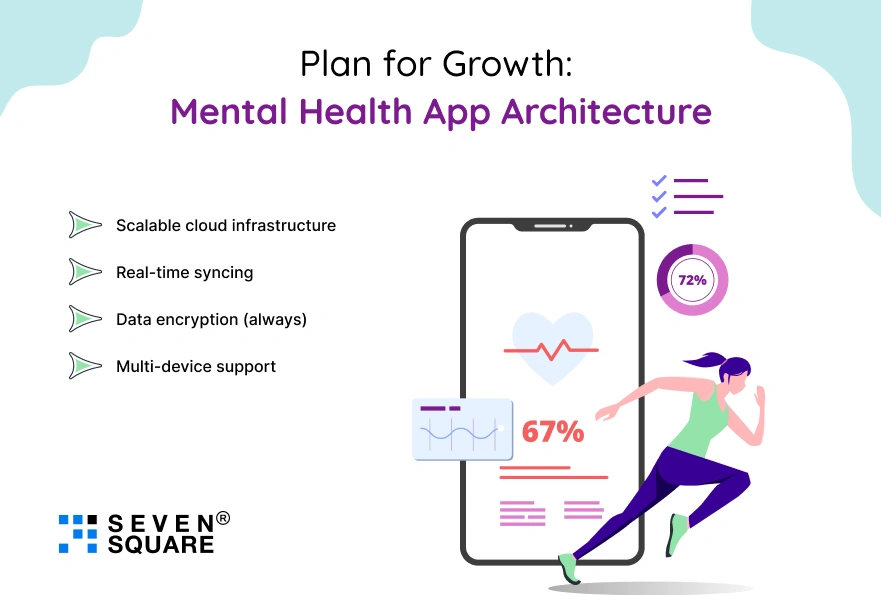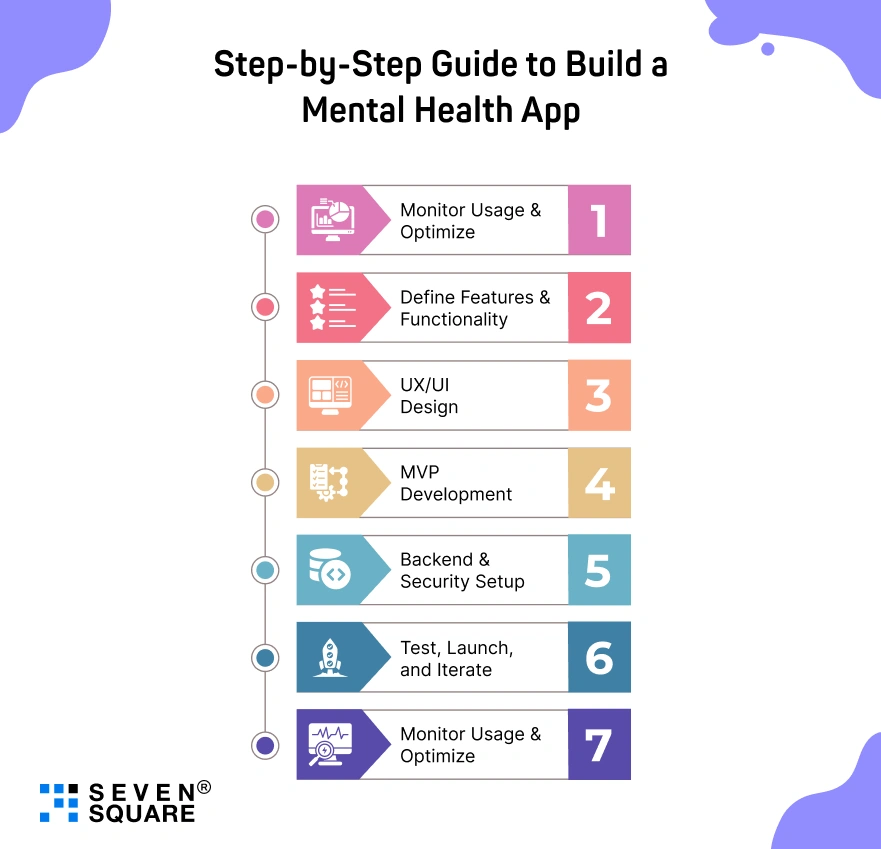Imagine this: It’s 3 a.m., and someone is wide awake, staring at the ceiling, anxiety weighing down like a boulder.
They pick up their phone looking for comfort. The mental health app they downloaded feels cold and clunky.
It doesn’t understand them. They close it. You’ve just lost a user, maybe forever.
This is exactly what we help founders avoid at Seven Square.
With years of hands-on experience building robust digital products across industries, we know what makes users stay.
Especially when it comes to mental health app development, empathy isn’t optional, it’s the foundation. And so is rock-solid tech.
Let’s go through how to build mental health app that users love.
This blog is perfect for you if you want to learn about mental health app development and important mental health app features that everyone loves.
Start with the User, Not the Code
A successful mental health app design begins with understanding real user pain points.
Think less about features and more about feelings. What do your users need in their darkest moments?
At Seven Square, our process begins with user research and product discovery. This is where mental health app UX design becomes your foundation.
We listen before we build & see that apps win when they:
- Feel safe and welcoming
- Are simple, not overwhelming
- Offer small wins (mood tracking, breathing exercises, etc.)
- Connect users to human or AI support fast
The goal? Emotional clarity and easy functionality.
Nail Down the Must-Have Mental Health App Features
Here are the core mental health app features your product can’t afford to miss:
- Mood tracking : Let users log how they feel in seconds.
- Personalized content : Articles, tips, or exercises based on behavior.
- Progress insights : Help them see how far they’ve come.
- Progress insights : Help them see how far they’ve come.
- SOS and emergency support : For crisis situations.
- Live chat or chatbot : Real-time relief.
- Privacy and security : HIPAA and GDPR compliance are non-negotiable.
We recently delivered a custom solution for a mental wellness startup focused on veterans.
It had one job: build trust. By creating a unique feature set around their trauma experience, we helped increase retention by 40% in the first month.
Think Product, Not Just Code
Most teams can code an app. But building one that feels right, and gets used requires product thinking.
Our approach to mental health app development includes:
- Behavioral design (nudges, habit loops)
- Accessibility by default (dark mode, large fonts, screen reader support)
- Simple onboarding (no 12-step forms)
- Regular feedback loops (user surveys, A/B tests)
This is where a strong mental health app architecture makes or breaks you. Your backend must scale without lag.
Your database must protect sensitive user data. And your analytics must track meaningful usage metrics.
At Seven Square, we build with these non-negotiables from day one.
Design with Empathy: UX Matters
Want your app to feel like a human, not a machine? Then UX isn’t optional.
Mental health app UX design is about:
- Micro-interactions that feel calming (animations, colors)
- Tone of voice that reassures and supports
- Zero-friction navigation
We recently redesigned a client’s therapy booking app.
Before our work, users were dropping off before completing their first session. After our UX redesign? The completion rate jumped by 55%.
That’s the difference between good UX and real UX.
Plan for Growth: Mental Health App Architecture

Too many apps break when they start scaling. Your users don’t care about your servers but they’ll quit if your app crashes.
A resilient mental health app architecture needs:
- Scalable cloud infrastructure
- Real-time syncing
- Data encryption (always)
- Multi-device support
Our engineers work hand-in-hand with product teams to avoid common pitfalls. It’s why founders trust us to launch, scale, and sustain their platforms.
Step-by-Step Guide to Build a Mental Health App

To build a mental health app that users love isn’t magic, it’s a process. Here’s the structured path we follow:
- User Research & Validation : Understand your audience. Conduct surveys, interviews, and competitor analysis to validate the problem and what users truly need in a mental health app.
- Define Features & Functionality : Start lean. Focus on key functionalities like mood tracking, journaling, guided meditations, and emergency support. Prioritize based on user pain points.
- UX/UI Design : Design experiences, not just interfaces. Keep it simple, warm, and accessible. Test wireframes and prototypes with users before moving to development.
- MVP Development : Build a minimum viable product with must-have features. Use agile development cycles to iterate quickly based on feedback.
- Backend & Security Setup : Design secure, scalable infrastructure. Ensure compliance with HIPAA or GDPR. Implement user authentication, data encryption, and role-based access controls.
- Test, Launch, and Iterate : Run usability tests. Launch to a small user group. Gather real-world feedback, fix bugs fast, and enhance the product incrementally.
- Monitor Usage & Optimize : Use analytics to track engagement. Focus on improving mental health app user retention with personalization and re-engagement strategies.
Keep Them Coming Back: User Retention
Acquisition is hard. Retention is harder. But if your users return, you’re winning.
Our retention strategies focus on:
- Push notifications that respect the user’s mental state
- Gamified tracking and encouragement
- Weekly progress emails or in-app messages
- Community features (if aligned with the product)
These techniques build mental health app user retention into your product from day one. Done right, it feels personal and non-intrusive.
How to Make It Safe: App Security & Compliance?
A mental health app handles deeply personal data. You must prioritize security and compliance.
Our stack includes:
- HIPAA-compliant architecture
- Two-factor authentication
- Role-based access control
- Secure audit trails
And yes, we walk founders through the compliance maze step-by-step. No stress.
How Seven Square Can Help You Build a Mental Health App That Truly Helps?
We co-create digital health solutions with purpose and precision. Here’s what makes us different:
- Design that doesn’t just look good but makes anxious or overwhelmed users feel safe and understood.
- Built-in HIPAA, GDPR, and security protocols from day one. No compliance surprises later.
- From research and design to testing and launch, we’re your dedicated product team.
- No confusing updates or delays. Just direct, honest, and regular conversations.
What We Built?
Meditation Wise: Personalized Meditation App
- Personalized Experience Engine : We built an AI-based recommendation system that served customized meditation sessions based on the user’s emotional state, time of day, and behavior patterns to boost daily engagement rates by over 40%.
- Smooth Audio Streaming : Created a smooth, lag-free streaming backend for guided meditations across devices to ensure users stayed in flow with no buffering, and no interruptions.
- Mindful UX/UI Design : Designed a calming, accessible interface tested with real users experiencing anxiety and burnout, resulting in a 35% increase in session completion.
Whether you’re launching your first mental health app or evolving an existing one, we’re here to help you do it right.
We bring clarity, speed, and engineering depth, and we care about the impact your app will have.
Want to build a mental health app? Contact Us Now!
Always Remember To Build Fast, Learn Faster
Here’s what we’ve learned: the longer you delay launch, the fuzzier your product-market fit becomes.
The right way?
Start small, launch early, and listen to users.
Our philosophy is built on swift delivery, clear communication, and uncompromising quality.
That means your MVP goes live in weeks, not months. Then we refine it with real usage data.
We use this method across industries from edtech to healthtech. And it works. Every time.
FAQs
- A successful mental health app should include features like guided meditations, mood tracking, cognitive behavioral therapy exercises, journaling, AI-based personalization, and 24/7 crisis resources.
- These help users feel supported, not just tracked.
- Apps like Calm and Headspace nailed engagement through consistent value delivery, and you can too by solving real user needs.
- To stand out, focus on user-centric design, personalized experiences, and actual outcomes.
- Many mental health apps are just glorified timers.
- If you build mental health app that feels human and helpful, it will make users stay.
- For most mental health startups, building a cross-platform app with tools like React Native or Flutter offers faster delivery and cost savings.
- Unless you need OS-specific features (like Apple HealthKit or advanced Android sensors), cross-platform works just fine. We’ve shipped both smoothly.
- Users love mental health apps that feel personal, intuitive, and genuinely helpful.
- Features like mood tracking, progress visualization, and real-time emotional support build emotional connections.
- We prioritize human-first UX so users don’t just download the app, they use it daily.